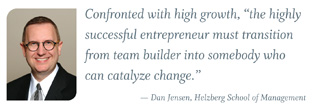Often, he said, that happens when a company reaches $2–$3 million in revenue, a figure that tends to separate the lifestyle entrepreneur from his rapid-growth counterpart.
“As you enter into rapid growth, these are people who are looking for people like them, who can view the business from a holistic perspective, a Mini-Me, if you will,” Jensen said. “Their role now is to be a team builder, directing other leaders who have direct reports of their own. This increases the levels of hierarchy. They are taken out of direct connection with running the business, and trying to inculcate that culture inside each of those key employees.
“This,” he said, “is where the highly successful entrepreneur must transition from team builder into somebody who can catalyze change.” At that phase, the nature of a company’s products and services may shift as the mission is redefined to attack new markets, even new lines of business, that have been identified.
Cases in Point
Scott Coons, who inherited the chief executive’s desk at Perceptive Software in 1994, can tell you about redefined missions. Coons took a six-year-old document management company and transformed it into a rapid-growth organization by focusing on the much more comprehensive field of enterprise content management. Building it into one of the world’s 10 largest in that sector, he positioned Perceptive for a $280 million sale to Lexmark last spring.
From the five employees he had after an initial retrenchment, Perceptive grew to more than 500, and $68 million in revenues, by 2009. That arc reinforced in Coons the need to bring in good people, and fast.
“Too many entrepreneurs have a personality where they think they have to do everything,” Coons said. “At the end of the day, the successful ones realize that while they have the ability to do everything, they shouldn’t do everything. You’ve got to understand as a business founder where your strengths, likes, dislikes and weaknesses are, and how to build out a team that complements you in the right areas, and empower them to do their job—all the while understanding the mission, strategy and what makes us different and keeping to the cores of the original businesses.”
Success for any business, Coons said, primarily comes down to having a superior product or service and hitting the marketplace with it at the right time, but most important, having the right people in place to enact the strategic vision.
Keith Koehler, co-founder of a company that soared to No. 1 on Ingram’s Corporate Report 100 in 2008, said one of the most important things for a chief executive in a rapid-growth scenario was maintaining a focus on larger growth issues, rather than getting drawn into day-to-day matters.
“From an operational standpoint, you should have a strong chief operating officer, or operations person, to manage the projects,” said Koehler, who along with Robert Penland sold Acceleration LLC last year before launching a new company, ce2l. “It depends on the industry you’re in, but you really need someone to manage projects and make sure they stay on track. If you don’t have somebody watching over that closely, it kind of slips.”
Even when the orders are pouring in and a business is profitable, Koehler said, rapid growth can be a minefield to navigate.
“Some of the problems you may have are masked by that growth,” he said. “Operationally, if you’re not maximizing your throughputs as efficiently as you could, that can be hidden by growth. You can still be very profitable, be a good company, but you definitely may have some problems that become glaringly obvious when the economy tanks.”
Geiger, back at Clinipace Worldwide, said the most important thing a business owner could do at the first sign of unexpectedly rapid growth would be “to put an infrastructure in place.”
“Plan for the growth, and grow on that infrastructure, instead of having growth and trying to put one in place while that is going on all around you,” she said. She also offered this counsel to those wrestling with whether to push on or step back from the CEO’s chair by taking on a majority partner, “go into it with your eyes wide open. You’ll see things differently in that new role, but that doesn’t make it bad; it’s just a fact of life. As long as you go into that relationship understanding that things will be different, you’ll be OK. If you go into it thinking that nothing really changes, that’s when you run into trouble.”
The flip side, she said, is that with a partner to help continue the growth curve, “you’ve got an organization that is now going to achieve, where 1 plus 1 equals 3, because you can do even greater things.”
Their stories illustrate the differences that Rockhurst’s Jensen draws between rapid-growth and lifestyle entrepreneurs.
“They really are different animals,” he said. “Lifestyle entrepreneurs, I can’t tell you how many I know that fall in that category. They have solid businesses, but aren’t going to grow beyond where they are because they don’t know how to let go, and it’s usually around control issues. They are always going to be that great local gem that won’t become a regional or national presence.”
“Rapid-growth entrepreneurs,” by contrast, he said, “understand that they have got to let go in order to grow.”
